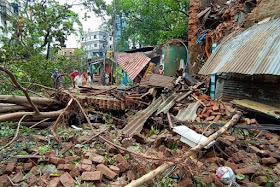At least 87 people have died in India and Bangladesh after Cyclone Amphan made landfall in the Indian State of West Bengal on Wednesday 20 May 2020, bringing with it winds at speeds of up to185 km per hour and a storm surge 4 m high. The majority of the deaths have occurred in West Bengal, where 72 people are known to have died, with a further twelve recorded deaths in Bangladesh and three in the Indian state of Odisha. Kolkata alone has suffered twelve known fatalities, as well as widespread flooding in low-lying parts of the city, and widespread power failures. The districts of North 24 Parganas, South 24 Parganas, and Minakha districts are reported to have suffered widespread devastation, with widespread flooding and tens of thousands of homes destroyed. In Bangladesh around half a million people are reported to have been made homeless and around five million have lost electricity. The number of deaths is thought to have been greatly reduced by the evacuation of around 2.4 million people from low-lying areas in Bangladesh and about 650 000 people from low-lying areas in West Bengal and Odisha.
Flooding in Bangladesh as Cyclone Amphan made landfall on Wednesday 20 May 2020. Xinhua.
Tropical
storms, called Cyclones in the Indian Ocean and South Pacific, are caused by solar energy heating the air above the oceans,
which causes the air to rise leading to an inrush of air. If this
happens over a large enough area the inrushing air will start to
circulate, as the rotation of the Earth causes the winds closer to the
equator to move eastwards compared to those further away (the Coriolis
Effect). This leads to tropical storms rotating clockwise in the
southern hemisphere and anticlockwise in the northern hemisphere. These
storms tend to grow in strength as they move across the ocean and lose
it as they pass over land (this is not completely true: many tropical
storms peter out without reaching land due to wider atmospheric
patterns), since the land tends to absorb solar energy while the sea
reflects it.
A house destroyed by a falling tree in Nadia District, West Bengal, during the passage of Cyclone Amphan. PTI.
Despite the obvious danger of winds of this speed, which can physically
blow people, and other large objects, away as well as damaging buildings
and uprooting trees, the real danger from these storms comes from the
flooding they bring. Each drop millibar drop in air-pressure leads to an
approximate 1 cm rise in sea level, with big tropical storms capable of
causing a storm surge of several meters. This is always accompanied by
heavy rainfall, since warm air over the ocean leads to evaporation of
sea water, which is then carried with the storm. These combined often
lead to catastrophic flooding in areas hit by tropical storms.
Damage in Kolkata following the passage of Cyclone Amphan on 20 May 2020. Sandipan Chatterjee/Outlook India,
See also...
Follow Sciency Thoughts on Facebook.









